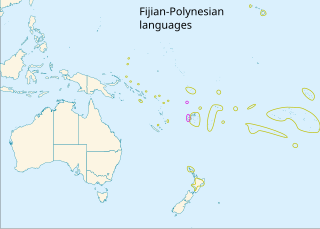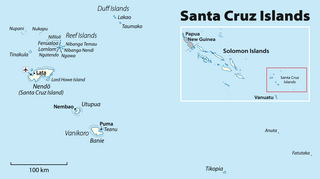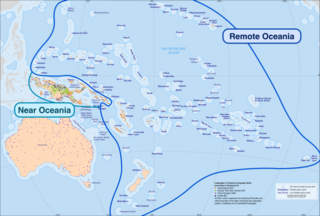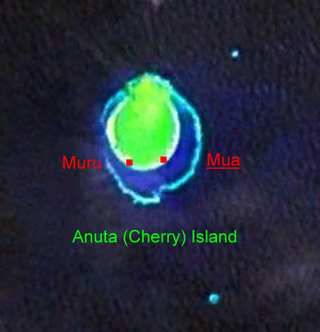
Melanesia is a subregion of Oceania in the southwestern Pacific Ocean. It extends from New Guinea in the west to the Fiji Islands in the east, and includes the Arafura Sea.

The Polynesian languages form a genealogical group of languages, itself part of the Oceanic branch of the Austronesian family.

Pacific Islanders, Pasifika, Pasefika, Pacificans or rarely Pacificers are the peoples of the Pacific Islands. As an ethnic/racial term, it is used to describe the original peoples—inhabitants and diasporas—of any of the three major subregions of Oceania.

The Lapita culture is the name given to a Neolithic Austronesian people and their distinct material culture, who settled Island Melanesia via a seaborne migration at around 1600 to 500 BCE. The Lapita people are believed to have originated from the northern Philippines, either directly, via the Mariana Islands, or both. They were notable for their distinctive geometric designs on dentate-stamped pottery, which closely resemble the pottery recovered from the Nagsabaran archaeological site in northern Luzon. The Lapita intermarried with the Papuan populations to various degrees, and are the direct ancestors of the Austronesian peoples of Polynesia, eastern Micronesia, and Island Melanesia.

The Santa Cruz Islands is an archipelago in the Pacific Ocean, part of Temotu Province of the Solomon Islands. They lie approximately 250 miles to the southeast of the Solomon Islands archipelago. The Santa Cruz Islands lie just north of the archipelago of Vanuatu, and are considered part of the Vanuatu rain forests ecoregion.

Near Oceania is the part of Oceania that features greater biodiversity, due to the islands and atolls being closer to each other. The distinction of Near and Remote Oceania was first suggested by Pawley & Green (1973) and was further elaborated on in Green (1991). The distinction is based on geology, flora and fauna. Near Oceania was also settled by humans at an earlier time than Remote Oceania was. Near Oceania includes the island of New Guinea, Solomon Islands(excluding Temotu) and the Bismarck Archipelago. Sometimes Australia is also included in Near Oceania.

Anuta is a small volcanic island in the province of Temotu in the southeastern part of Solomon Islands. It is one of the smallest permanently inhabited Polynesian islands. It is one of the Polynesian Outlier communities in Melanesia.

The approximately 450 Oceanic languages are a branch of the Austronesian languages. The area occupied by speakers of these languages includes Polynesia, as well as much of Melanesia and Micronesia. Though covering a vast area, Oceanic languages are spoken by only two million people. The largest individual Oceanic languages are Eastern Fijian with over 600,000 speakers, and Samoan with an estimated 400,000 speakers. The Gilbertese (Kiribati), Tongan, Tahitian, Māori and Tolai languages each have over 100,000 speakers. The common ancestor which is reconstructed for this group of languages is called Proto-Oceanic.

A tepukei, tepuke or TePuke is a Polynesian boat type, characterized by its elaborate decking, its submerged hulls and symmetrical "crab claw" sail slender foil or radically extended tips claw sail. Tepukei boats are produced primarily by the Polynesian-speaking inhabitants of Taumako, and have been occasionally borrowed by other Polynesian and Melanesian societies.

The family of Southeast Solomonic languages forms a branch of the Oceanic languages. It consists of some 26 languages covering the Eastern Solomon Islands, from the tip of Santa Isabel to Makira. The fact that there is little diversity amongst these languages, compared to groups of similar size in Melanesia, suggests that they dispersed in the relatively recent past. Bugotu, Gela and "supposedly" Lengo are three of the most conservative languages.

The Indigenous peoples of Oceania are Aboriginal Australians, Papuans, and Austronesians. These indigenous peoples have a historical continuity with pre-colonial societies that developed on their territories. With the notable exceptions of Australia, New Zealand, Hawaii, New Caledonia, Guam, and Northern Mariana Islands, indigenous peoples make up the majority of the populations of Oceania.

Temotu is the easternmost province of Solomon Islands. The province was formerly known as Santa Cruz Islands Province. It consists, essentially, of two chains of islands which run parallel to each other from the northwest to the southeast. Its area is 895 square kilometres.

The Central Solomon languages are the four Papuan languages spoken in the state of Solomon Islands.

Mota is an island in the Banks group of northern Vanuatu. Its population – today about 700 people – speak the Mota language, which Christian missionaries of the Anglican Church used as a lingua franca in parts of Melanesia.
The Reef Islands – Santa Cruz languages are a branch of the Oceanic languages comprising the languages of the Santa Cruz Islands and Reef Islands:

The Solomon Islands (archipelago) is an island group in the western South Pacific Ocean, north-east of Australia. The archipelago is in the Melanesian subregion and bioregion of Oceania and forms the eastern boundary of the Solomon Sea. The many islands of the archipelago are distributed across the sovereign states of Papua New Guinea and Solomon Islands. The largest island in the archipelago is Bougainville Island, which is a part of the Autonomous Region of Bougainville along with Buka Island, the Nukumanu Islands, and a number of smaller nearby islands. Much of the remainder falls within the territory of Solomon Islands and include the atolls of Ontong Java, Sikaiana, the raised coral atolls of Bellona and Rennell, and the volcanic islands of Choiseul, Guadalcanal, Makira, Malaita, New Georgia, the Nggelas, Santa Isabel, and the Shortlands. The Santa Cruz Islands are not a part of the archipelago.
The family of Northwest Solomonic languages is a branch of the Oceanic languages. It includes the Austronesian languages of Bougainville and Buka in Papua New Guinea, and of Choiseul, New Georgia, and Santa Isabel in Solomon Islands.

Between 60 and 70 languages are spoken in the Solomon Islands archipelago which covers a broader area than the nation state of Solomon Islands, and includes the island of Bougainville, which is an autonomous province of Papua New Guinea (PNG). The lingua franca of the archipelago is Pijin, and the official language in both countries is English.

Nendö is the largest of the Santa Cruz Islands, located in the Temotu province of Solomon Islands. The island is also known as Santa Cruz, Nendo, Ndeni, Nitendi or Ndende. The name Santa Cruz was given to the island in 1595 by the Spanish navigator Álvaro de Mendaña, who started a colony there. Historically, the island has also been called New Guernsey and Lord Egmont's Island, after John Perceval, 2nd Earl of Egmont, First Lord of the Admiralty.
Gerd Koch was a German cultural anthropologist best known for his studies on the material culture of Kiribati, Tuvalu and the Santa Cruz Islands in the Pacific. He was associated with the Ethnological Museum of Berlin. His field work was directed to researching and recording the use of artefacts in their indigenous context, to begin to understand these societies.




















